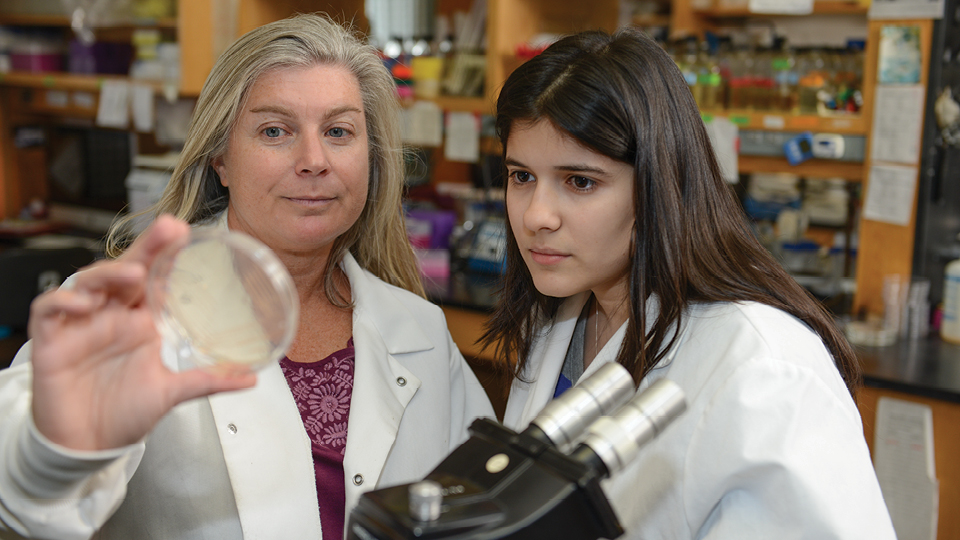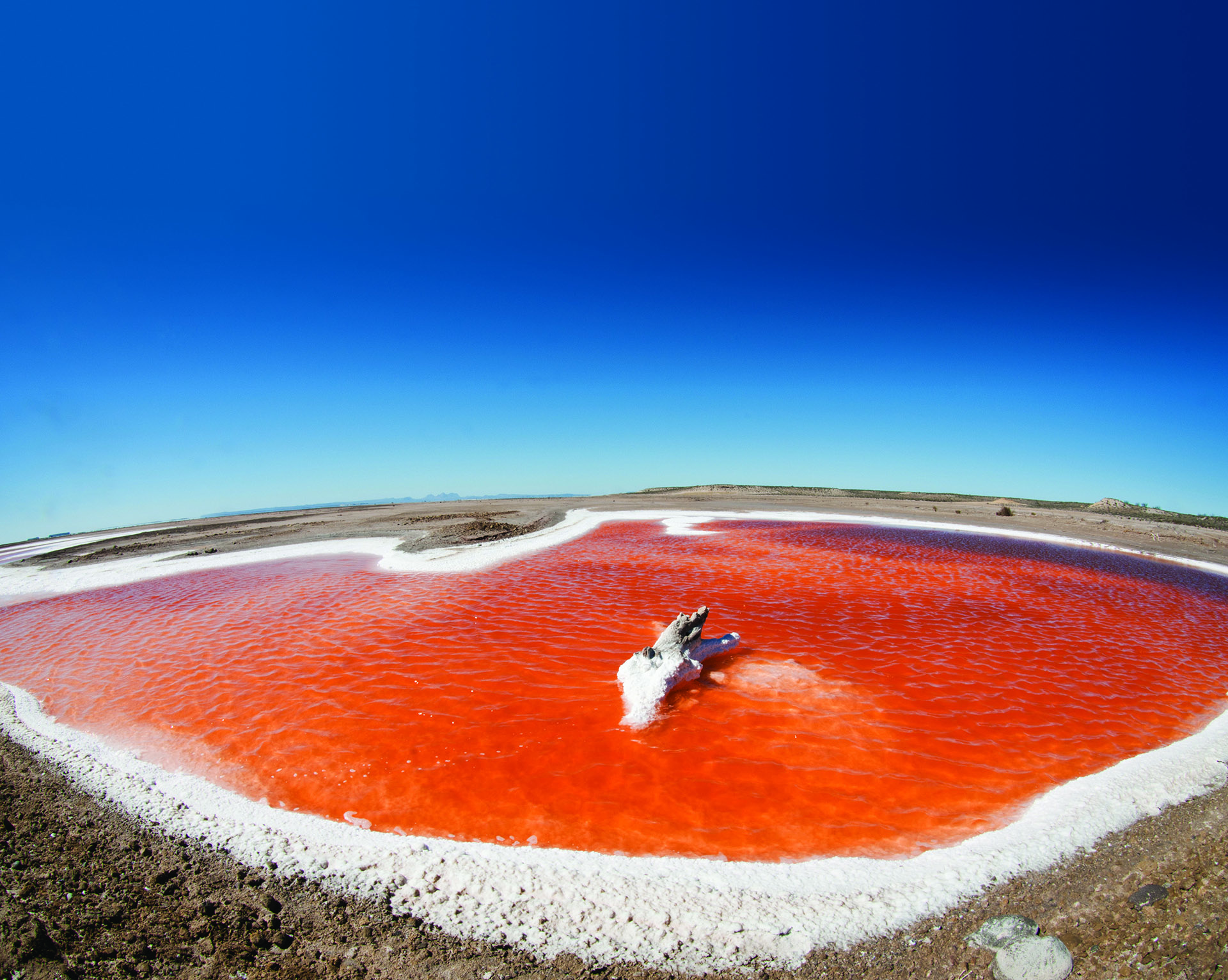by Adam Grybowski
Several lakes on earth contain 10 times or more the amount of salt found in seawater. Known as hypersaline lakes, they were long considered inhospitable to animal life, leading to names like the Dead Sea. But in the 1960s, scientists began discovering organisms that had evolved to live in extreme conditions like hypersaline lakes, revolutionizing our conception of life on this planet and possibly elsewhere.
These microscopic organisms — known generally as extremophiles — began to evolve billions of years ago to survive in inhospitable conditions. Today, they are the kings and queens of their environments, dominating where few other organisms have ever been found to live. In their genetic material, they hold the keys to understanding the origin of life. In their mind-bending adaptability, they promise to shed light on how life could exist elsewhere in the universe.
“Studying organisms found in places where life normally isn’t supported allows you to push the boundaries of traditional scientific views,” says Dr. Kelly Bidle, a Rider University biology professor and microbial geneticist who has studied extremophiles for more than two decades.
Salt-loving organisms called halophiles thrive in high concentrations of salt that would cause most life forms to desiccate and die. Heat-loving organisms called thermophiles exist in hot springs and geysers, withstanding temperatures well above that of boiling water. Other such organisms have found ways to live in ice, the deep sea and underground. Some grow in environments with little traces of oxygen, others in high levels of radiation. Each raises the question: What are the limits of life?
Halophiles turn the water of the San Ignacio Lagoon in Baja California, Mexico, a reddish color. (James Forte/Getty Images)
On a cold winter day in the middle of January, a few days before the start of the spring semester, three of Bidle’s undergraduate students gathered in her lab on the second floor of Rider’s Science and Technology Center. Tossing backpacks on the floor and draping jackets over chairs, the students — all young women, two of whom study art in addition to science at Rider — were there to continue an experiment they had begun the previous day.
In the lab, the students were culturing an organism called Haloferax volcanii. Being a halophile, which comes from the Greek word for “salt-loving,” Haloferax volcanii evolved to live in environments marked by high salinity. In creating a medium of distilled water to culture the organism, the students had to add a lot of salt to it, making it about five times as salty as seawater. “If we lived in that kind of environment, that would be terrible, but they thrive in it,” says Shayna Holness ’18, a Westminster Choir College junior from Irvine, Calif., who has the unlikely double major of voice performance and biochemistry.
Holness came to Rider already interested in extremophiles, having observed as a teenager the famous hot springs at Yellowstone National Park, where some bacteria and viruses live in temperatures up to 237 degrees Fahrenheit. Like halophiles, the existence of such bizarre forms of life in Yellowstone and other hostile places continues to stretch the imaginations of scientists. Although many extremophiles are the most ancient on earth, some scientists speculate that they are also the most likely to be found elsewhere in the universe because of their ability to adapt and survive in extreme conditions.
“Microorganisms are so small, but there’s so much to learn from them,” says Emily George ’16, a senior from Gladstone, N.J., who, along with Holness and another student, Adriana Bellomo ’17, worked for three months as paid undergraduate research assistants in Bidle’s lab at Rider the previous summer.
The lab work George, Bellomo and Holness were conducting under Bidle’s supervision allowed them to visualize Haloferax volcanii under the microscope, isolate DNA and RNA, and conduct experiments on the organism’s genes. They could also measure the amount of enzymatic activity in the halophile’s proteins, which gave them insight into one of Bidle’s core areas of research: the mechanisms of programmed cell death.
Programmed cell death, or PCD, is a fear-inducing name for a process that is actually fundamental to multicellular organisms such as humans. Our entire nervous system, not to mention our fingers and toes, are all the result of PCD. While the process is present and important in many forms of life, for many years scientists had failed to find any trace of it in the microbial organisms that make up one of the three major domains of life, the Archaea.
In collaboration with her husband, Dr. Kay Bidle of Rutgers University, Bidle discovered that proteins responsible for initiating and executing PCD are present in Haloferax volcanii, which, like most extremophiles, are categorized in the archaeal domain. “It seems like these proteins originally served a different purpose in Archaea and these proteins have been conserved and retooled by different, complex multicellular organisms through evolutionary time,” Bidle says. The work promises to reveal the context, nature and function of a core biochemical activity that has been retained through billions of years of evolution, from the first bacteria to human beings.
“When you look at these ancient microbes, you find genes that are in multicellular organisms today,” Bidle says. “I find it fascinating how long they’ve persisted on earth virtually unchanged from how they first arose.”
As an undergraduate at Rutgers in the late 1980s, Bidle worked in a research lab that studied marine life. In graduate school at the University of Maryland, where she received her doctorate in 1996 in molecular and cell biology, she shifted focus to bacteria living in hydrothermal vents deep in the ocean — a subject that was still very new relative to other life forms.
“From the first day of graduate school, I didn’t want anything to do with fish anymore,” Bidle says. “When you have organisms that you know little about, it’s an open book. From a creative perspective, there are so many questions you can ask.”
Many of Bidle’s students are drawn to her classes because of an interest in genetics, but they are also drawn into Bidle’s orbit because of her strength as a mentor, skill as a researcher and active interest in the success of her students. At least 10 of her students have gone on to receive doctorates. Last year, two of them, Brandon Enalls ’15 and Danielle Minichino ’15, were accepted into Ivy League doctoral programs — the first time in Rider’s history that two students from the same class entered such programs directly from their undergraduate years. Last fall, Enalls began studying organismic and evolutionary biology at Harvard University, and Minichino began studying cell and molecular biology at the University of Pennsylvania.
Despite the academic and professional achievements of her students, Bidle, who received Rider’s Frank N. Elliot Award for Distinguished Service in 2014 for her many contributions to the University, finds satisfaction in her job simply when she sees lab work generating excitement and passion within her young researchers. “Without that, you might as well not do research,” she says. “It often feels like a lonely, solo pursuit, and it definitely has its highs and lows, but when it works, it’s so exciting.”
In a student research lab, mistakes are plentiful, success less so. “And sometimes if you do everything right, it still doesn’t work,” says George, one of Bidle’s students. “You can work for so long and it doesn’t work — that’s science. But Kelly has always reassured me through the process.”
Holness adds, “Even when something is going wrong, there are still things to find out. The mystery of it always brings me back because I’m interested in what is going on and why.”
In addition to PCD, Bidle and her students continue to study another aspect of halophiles and their evolutionary connection to more complex life forms. Bidle’s group recently identified that Haloferax volcanii appears to display a primitive form of biological signals generally known as circadian rhythms. Most forms of life, from bacteria to human beings, express such signals, but they have not been definitively detected in the Archaea.
During Bidle’s research, conducted in collaboration with colleague Dr. Phillip Lowrey, associate professor of biology at Rider, the organisms appear to undertake certain activities based on whether it’s day or night, suggesting that they may have a circadian rhythm — another link in the evolutionary chain.
“We still have so much to learn,” Bidle says. “We’ve only scratched the surface.”


